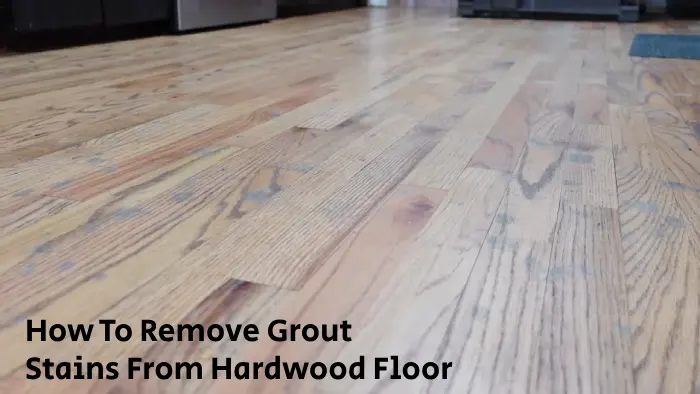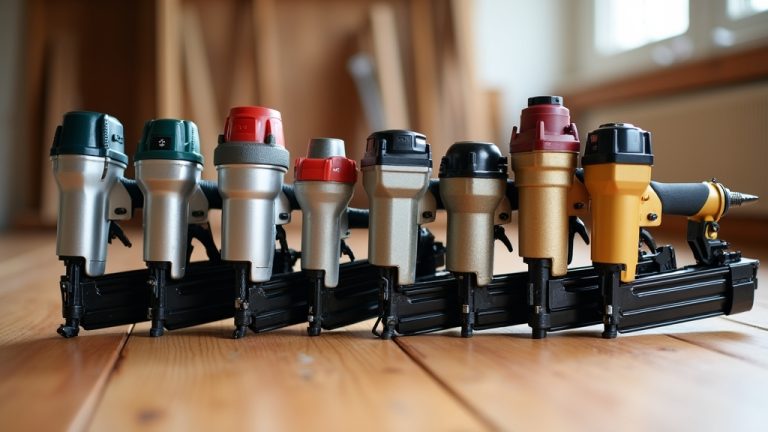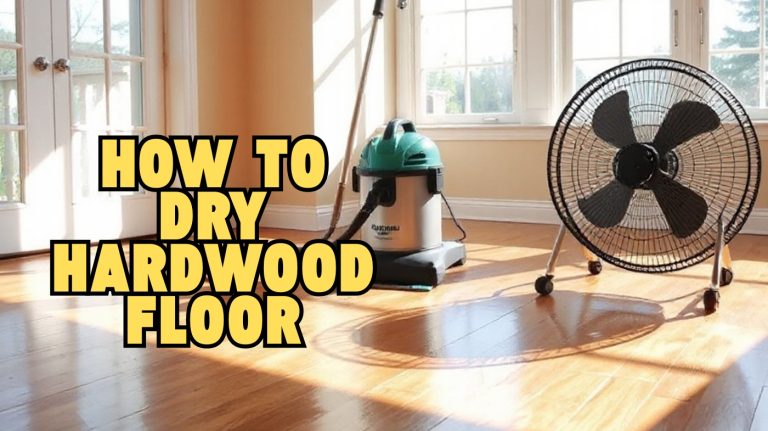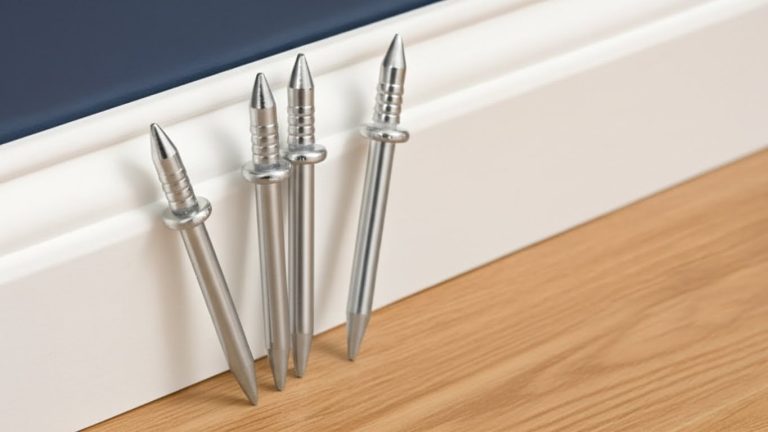How to Fix a Warped Hardwood Floor: Solid Strategy
To fix a warped hardwood floor, first identify the warp type: cupping, buckling, peaking, or crowning, and measure moisture levels in the boards and subfloor. Dry any excess moisture using dehumidifiers and guarantee proper acclimation before repairs.
Minor warps may require sanding or weighted compression, while severe damage might need board removal and gluing. Maintain indoor humidity between 40-60% to prevent recurrence.
By understanding these steps, you’ll be better equipped to restore your floor’s stability and appearance effectively.
Key Takeaways
- Identify the warp type (cupping, buckling, peaking, crowning) to determine the appropriate repair method.
- Use a moisture meter to check and dry subfloor and boards with dehumidifiers before repairing warped areas.
- Sand minor warps or apply weights to cupped boards; remove and reinstall severely warped planks with proper acclimation.
- Ensure proper expansion gaps and secure boards correctly during repair to prevent future warping.
- Maintain indoor humidity at 40-60% and fix leaks promptly to avoid moisture-related floor warping.
Identifying Different Types of Hardwood Floor Warping
When dealing with warped hardwood floors, you first need to identify the specific type of warping to address the problem effectively.
- Cupping shows edges rising above the center, indicating moisture under the flooring.
- Buckling involves boards sharply lifting, often from lack of expansion gaps and excessive moisture.
- Peaking forms sharp ridges along board seams, usually due to tight installation without proper spacing.
Crowning is the reverse of cupping, with the plank centers raised higher than edges, often following drying after cupping or uneven sanding. Regular maintenance such as vacuuming hardwood floors with gentle attachments can help prevent moisture buildup that contributes to crowning.
While shifting and gapping aren’t warping shapes, they involve board separation caused by drying or structural issues.
Recognizing these distinct patterns helps you pinpoint moisture or installation problems to plan precise repairs. Addressing the source of moisture promptly is crucial since excessive moisture is the primary cause of hardwood floor warping.
Diagnosing Moisture and Installation Issues
Once you’ve identified the type of warping affecting your hardwood floor, the next step is to diagnose underlying moisture and installation issues that often cause these deformations.
Use a pinless moisture meter to scan multiple boards and subfloor areas, ensuring moisture content aligns between 6% and 9%, matching local equilibrium moisture content (EMC) standards. Taking multiple readings at different locations helps ensure accurate moisture content.
Additionally, understanding how temperature influences material expansion can help predict areas prone to warping. Check for moisture vapor emissions from concrete subfloors and signs of previous water damage.
Confirm the flooring was properly acclimated with adequate air circulation before installation. Fire sprinklers, which activate at specific heat thresholds, can be an important consideration for overall fire safety in wooden structures.
Also, assess adhesive and fastener use to ensure they allow necessary wood movement. Improper acclimation, excessive subfloor moisture, or restrictive installation methods frequently cause cupping, crowning, or buckling.
Accurate moisture readings and installation verification are critical to identifying the root causes before proceeding to repair.
Step-by-Step Repair Methods for Warped Floors
Although repairing warped hardwood floors can be challenging, following a systematic approach guarantees effective restoration.
First, identify the warp type cupping, crowning, or buckling and assess the damage extent. Use moisture meters and dehumidifiers to dry the subfloor and floor thoroughly before starting.
Proper assessment ensures that underlying moisture problems are addressed, which is crucial to prevent future warping and damage. This step helps in identifying underlying moisture issues that must be resolved prior to repair.
For minor warps, sand high spots along the grain carefully, then clean and refinish. Alternatively, lightly wet cupped boards and apply weights for several days to flatten them, monitoring moisture closely. It is also important to inspect for water pooling in areas beneath the floor to avoid recurring moisture damage.
For severe warping or buckling, remove damaged boards precisely, trim replacement grooves, and glue tongues and grooves for a snug fit. Ensure the subfloor and boards are dry and acclimated before installation.
Preventative Measures to Avoid Future Warping
Repairing warped hardwood floors restores their function and appearance, but preventing future damage saves you time and expense.
To avoid warping, maintain indoor humidity between 40-60% using dehumidifiers or humidifiers as needed. Immediately fix leaks and clean spills to prevent moisture saturation.
Ensure proper installation by acclimating wood planks, testing subfloor moisture, and leaving expansion gaps. Use professional installation when possible and secure planks correctly.
Proper installation reduces the chance of improper installation causing warping. Apply and periodically renew a high-quality sealant to block moisture infiltration, sealing gaps and cracks.
Control temperature fluctuations with HVAC systems and maintain good ventilation, especially in damp areas. Use rugs in high-traffic zones to buffer moisture.
These precise controls on moisture, installation, and environmental factors considerably reduce warping risk, protecting your hardwood floors effectively over time.
Routine Maintenance and Monitoring Tips
Maintaining your hardwood floor’s integrity requires consistent routine care and vigilant environmental monitoring. Use a hygrometer to keep indoor relative humidity between 30-50%, adjusting with humidifiers or dehumidifiers seasonally to prevent wood expansion or contraction.
Regularly monitor temperature to avoid extreme fluctuations that stress the wood. Clean floors weekly with microfiber dusters and vacuums designed for hardwood to remove abrasive debris. Promptly wipe spills to prevent moisture absorption.
Additionally, addressing any external moisture sources such as leaks or damp foundations promptly can significantly reduce the risk of moisture damage. Using proper adhesives for transition strips can also help maintain floor stability where hardwood meets other flooring types.
Perform monthly visual inspections for warping signs like cupping or buckling, and check furniture pads to reduce surface damage. Apply waterborne or urethane-based polish thrice yearly to restore finish and protect against moisture infiltration.
Schedule annual professional deep cleanings and periodic recoating to maintain protective seals and extend floor lifespan, reducing warping risk.
Frequently Asked Questions
Can Warped Hardwood Floors Affect Home Resale Value?
You should know that 87% of homebuyers value hardwood floors for aesthetics, so warped flooring can substantially impact resale value.
Warped floors often lower your home’s appraised worth and deter buyers, as they signal potential maintenance issues. This can lead to reduced offers or negotiation hurdles.
Addressing floor warping improves buyer confidence and helps maintain or increase your property’s market value, especially in competitive markets where flawless hardwood commands premium prices.
Is It Safe to Walk on Severely Warped Hardwood Floors?
You shouldn’t walk on severely warped hardwood floors without caution. Warping creates uneven surfaces and loose boards that increase your risk of tripping or injury.
Buckled areas may pull away from the subfloor, compromising structural stability. If you must cross these spots, move carefully, avoid heavy impacts, and consider placing barriers to prevent accidents.
For safety, limit foot traffic until a professional evaluates and repairs the damage properly.
How Long Does It Take for a Warped Floor to Dry Completely?
Think of drying a warped floor like drying a soaked sponge; it depends on conditions. Typically, your warped hardwood floor takes anywhere from several days to a week or more to dry completely.
Factors like humidity, temperature, floor thickness, and previous water damage influence this. You’ll want to maintain 65°F-80°F and 30-50% humidity for ideal drying.
If your floor is heavily damaged, expect longer drying times before any repair or finishing steps.
Are Certain Hardwood Species More Prone to Warping?
Yes, certain hardwood species are more prone to warping due to their density, grain pattern, and moisture sensitivity. You’ll find softwoods and low-density hardwoods like soft maple warp more easily.
Hard maple, with its high hardness and straight grain, resists warping well. Oak can warp in dry conditions despite its density.
Woods like teak, rich in natural oils, resist moisture-induced warping better. Choosing species suitable for your environment helps minimize warping risks.
Can Warped Floors Cause Structural Damage to the House?
You might think warped floors only affect appearance, but they can cause serious structural damage. Warping often signals moisture issues that weaken your subfloor and joists, compromising your home’s stability.
Over time, this can lead to uneven load distribution, wood rot, and even mold growth. Addressing warped floors promptly helps maintain your floor’s integrity and prevents costly repairs to your home’s foundational structure.
Routine Rules: Regular Checks Keep Floors Resilient
By boldly battling bothersome bends and bulges in your hardwood floor, you’ll boost both beauty and balance in your home. Consistently checking for causes like moisture and installation mistakes can curb costly complications.
Following focused fixes and fostering foolproof preventative practices guarantees floors stay flat and flawless. Remember, routine reviews and responsible repair reinforce resilience, reducing the risks of recurring warping.
Stay sharp, stay steady, and safeguard your solid surfaces with smart, systematic care.




![How to Clean Syrup off Hardwood Floors: 6 Steps [DIY]](https://anyshelter.com/wp-content/uploads/2023/06/How-to-Clean-Syrup-off-Hardwood-Floors.webp)


